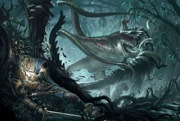Into the Darklands We Trod
Friday, September 12, 2008
It falls to me once again to reveal a tantalizing taste of some of the terrific tableaux contained within the pages of Pathfinder. Today I bring to you two pieces from Into the Darklands. The first is a bunch of drow and slaves leading freshly captured heroes into a drow city. Lucky them. The second is, well... it's an underground lost-world-type cavern where giant monsters fight dinosaurs. I think that speaks for itself. Have I mentioned before how much I love my job?
Enjoy!
Jacob Burgess
Online Retail Coordinator
We have updated our Privacy Policy.
Paizo.com uses cookies. You can block paizo.com from using cookies within your browser settings, but doing so will hinder site functionality.
More information can be found in our Privacy Policy.

